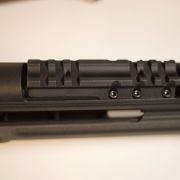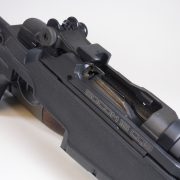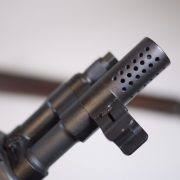Review: Springfield SOCOM 16 CQB M1A
Jon Stokes 05.30.16

Springfield’s new SOCOM 16 CQB M1A is a great version of a classic firearm, but it’s very difficult to review. The problem faced by any reviewer of this gun is the same as the problem faced by the gun itself: many people love the M14 family because it’s a classic firearm and they appreciate the classics, but this particular model has gone full tactical in a way that old-school, “gimme a wooden stock, a 24-inch barrel, and iron sights” M14 shooters love to hate on. On the other side of the fence, there are the AR and AK shooters for whom any M14 action gun is a sad, overpriced relic that should go the way of the dodo.
So when you write about a gun that embeds the classic Garand-derived action in a modern, lightweight, polymer frame with an adjustable AR stock and an AK-style grip, and then shortens the barrel to a scant 16 inches, you’re going to get it from both sides. The traditional M1 fanboys are eager to let you know that this new-fangled M1A CQB is a mall ninja abomination, and the AR and AK fanboys want to make clear that anyone who buys an M1 of any flavor when there are .30-caliber rifles on the market in their favorite pattern for less money is totally irrational and probably just suffering from an old head wound incurred in some Asian conflict that ended before they were born.
I’ve seen this time and time again whenever this gun comes up in my various feeds. It’s crazy the way that it manages to unite M1 purists, AR partisans, and AK lovers in complete agreement that This Gun Should Not Exist. This TFB comments thread on the new CQB model’s announcement, for instance, is a classic of the genre.
Indeed, had I known what a hornet’s nest I’d be stepping into, I’d have thought twice about signing up to do this review. But apparently I’m one of those rare birds who saw this gun and thought, “that looks awesome–a combination of the old and the new, the time-tested and the tactical. Assuming it works, why would anyone not love this?”
So let’s take a look at the newest iteration of Springfield’s M1A CQB, a gun that I’ve had in my safe since last year and have been taking out back to the range on my property on and off since I brought it home.
History of the M1A
The Springfield M1A line can trace its roots to an action that has been in service since 1936 and the US Army’s introduction of the M1 Garand. General Patton famously called the Garand “the greatest battle implement ever devised,” and much of the Garand’s basic gas-operated design was carried over to its successor, the M14.
The M14 replaced the M1’s clip-fed design with a detachable magazine that offered more capacity, and it changed the caliber from the venerable .30-06 to .308. There are some other changes to the gas system, but the two rifles are ultimately pretty similar and a number of the smaller parts are interchangeable.
The M14 is actually still in use in Afghanistan because the Marines pulled these rifles out of storage, upgraded them, and deployed them in order to be able to reach out to longer distances than they could with the AR platform. Because of the rifle’s current use in the War on Terror, it’s enjoying something of a renaissance among shooters.
The M1A line is Springfield Armory’s take on the M14, and the SOCOM family in particular does away with the traditional wood stock for lighter synthetic stocks, rails, and other modern enhancements that, depending on how attached you are to tradition, are either upgrades or sacrilege.
Features and Functions
The first thing you’ll notice about the new SOCOM is that it comes with the Archangel polymer stock, and it boasts an adjustable stock that’s mounted onto an extension tube that’s the size of the standard AR buffer tube. This means that the huge variety of AR stocks are now available on the M1A platform.
Like anything, the Archangel stocks have their fans and detractors. I’ve actually read mostly good about these, and in person I can testify to the fact that the stock does not feel at all flimsy or cheap. It’s a solid synthetic stock that looks like it can stand up to abuse.
These stocks have been available on the aftermarket for a while, and I think it’s good that Springfield is offering these from the factory now because it’s the kind of upgrade I’d have wanted to do anyway. The fit is supposedly tight, and it takes some doing, so it’s better just to have the rifle shipped that way.
The Archangel stock uses the M-Lok system for attaching rail pieces, with a three-slot rail at the 3 and 9 o’clock positions and a seven-slot rail at the 6 o’clock position. Unlike the M-Lok haters, I don’t have a problem with this at all. I think it’s great that I can easily mount a light on the side of this rifle yet still keep the aesthetics, weight, and ergonomics of the standard SOCOM 16. (The quad-railed SOCOM II is just too much for me. I don’t need that much rail and that much weight.)
The gun sports an AK-compatible pistol grip, which I actually like a lot. The buttstock sits on an AR-compatible, five-position tube.
As for optic mounts, there’s a seven-slot rail on the top, mounted far forward. You’ll need a medium or long eye relief scope for this or a red dot or similar optic. I think an Aimpoint of some flavor would be the ideal mate for this gun.
The built-in iron sights are solid with an XS Sights tritium front sight and a standard M14 rear peep sight that’s adjustable for windage and elevation.
The gun ships in a really nice ballistic nylon soft case that’s custom fit for it and includes a storage pocket for the manual and pouches for three spare mags.
Coming from the AR platform, as I do, there are a few things that will have you scratching your head at first. The safety is just weird, and I ended up leaving it alone.
The exposed operating rod takes some getting used to. If you’re an AR shooter who’s used to wrapping their hand around the forend all sorts of ways, you’ll going to need to be more careful here.
Finally, it took some practice for me to get comfortable changing magazines. I may never be as fast with it as I am on an AR-pattern rifle.
In all, though, after a few sessions I was pretty comfortable with the rifle and really started to enjoy shooting it.
Specs
- Caliber: .308 Win
- Magazines: Ships with one ten-round parkerized metal mag
- Barrel: 16.26-inch, 6-groove, 1:11″ right-hand twist
- Rear Sight: Enlarged Military Aperture .135 w/MOA Adjustment For Both Windage And Elevation
- Front Sight: XS Post with Tritium Insert, .125 Blade Front
- Trigger: Two-stage at 5 to 6 pounds
- Length: 35.0 inches to 38.5 inches (depending on stock position)
- Stock: Five-position CQB stock, M-Lok rail system
- Weight: 9.3 lbs.
At the Range
Just for jollies I pulled out my LMT LM308MWS (also with a 16″ barrel) and shot it a bit during most of the sessions when I took the M1A out. The contrast between how the two shoot is pretty major; the LMT is far softer, as the Stoner design does much to tame the recoil of the .308 round.
Despite being a tiny bit heavier, the SOCOM feels “faster” than the LMT; it’s handy rifle, which was one of the design goals. It just feels really great in the hand, and you get the impression that it’s nigh indestructible.
The SOCOM’s special muzzle brake mitigates some of the recoil that you get from running a .308 in a 16-inch barrel, but at the price of volume. This gun is quite loud, as my dogs can unhappily attest to.
I put a grab-bag of different .308 rounds from Winchester and Fiocchi through the SOCOM 16, and it happily ate everything I fed it. I even fed it some awful M80 ball that my LMT absolutely refuses to eat. I can get five rounds, tops, before a jam. The SOCOM puttered along, and it wasn’t until about round 16 that I had my first malfunction. The empty case stuck in the chamber and didn’t want to come out. That ended that experiment, and the M80 went back on the shelf.
As for accuracy, I’m not a long-range shooter by any means, though I plan to get into that this year. But for these tests I did most of my shooting at a mere 50 yards, seated at a bench with a bag.
With my LMT (running irons) I was getting three-inch groups, and those ballooned out to four inches with the SOCOM. (Yeah, go ahead and laugh. I know how it goes: you’re a Marine sniper, and on the Internet all guns shoot 1 MOA. Duly noted. Still, I figure that the one or two non-operators who end up reading this review will appreciate an honest take from a regular guy.)
The difference with the two guns partly comes down to familiarity. There’s also the fact that, as I noted above, the LMT’s recoil is a lot tamer, so I’m sure I’m flinching more with the SOCOM.
At some point when I actually learn more about bench rest shooting, and pick up some proper equipment, I’ll start doing accuracy comparisons with different load types. But for now, my own skill is the limiting factor, and the ammo isn’t going to make much of a difference.
Conclusions
I’ve enjoyed the SOCOM CQB 16 quite a bit so far, and I do hate to send it back. If I were looking for a SHTF battle rifle and I wasn’t already committed to the LMT LM308MWS, I’d grab this specific gun in a heartbeat. For the money, it’s hard to top. In fact, I’d take this even over the much more expensive SCAR 17s. I know that’s bound to get me flamed, but I’m actually not convinced that the SCAR is really and truly as well-tested and debugged as even the AR-10 platform, much less the M14. The ergos on the SCAR are superior in every way, but if I had to bet my life on which one would still be ticking along 20 years from now, I’d bet on the M1A.
This gun lists for $2,099, and it streets for between $1800 and $1900. I have to admit, the price is the main downside for this gun, and because of it some people are going to recommend you pick up something like a Ruger SR-762 for that amount of scratch. The Ruger is a great gun, for sure, but again it comes back to the fact that the SOCOM CQB has a time-tested, combat-proven action.
For a “truck gun” that can work well with iron sights only or a SHTF battle rifle, again, it’s hard for me to think of a better gun for the money. And I think the latter is really the target market, here. It’s certainly not a home defense weapon unless the walls of your house are reinforced with AR-500 plate. Similarly, I can’t image it really as a CQB weapon in an urban combat scenario–again, over-penetration and such. (Also, I’d just go with an AR if all I wanted to do was CQB, or a shotgun.)
So the real practical use-case for this gun, at least as far as I can tell, is as a one-size-fits-all, “one gun” type of weapon–something that you could clear a room with or reach out past 400 yards if you had to. And at that, in that role, it’s a fantastic fit.

















